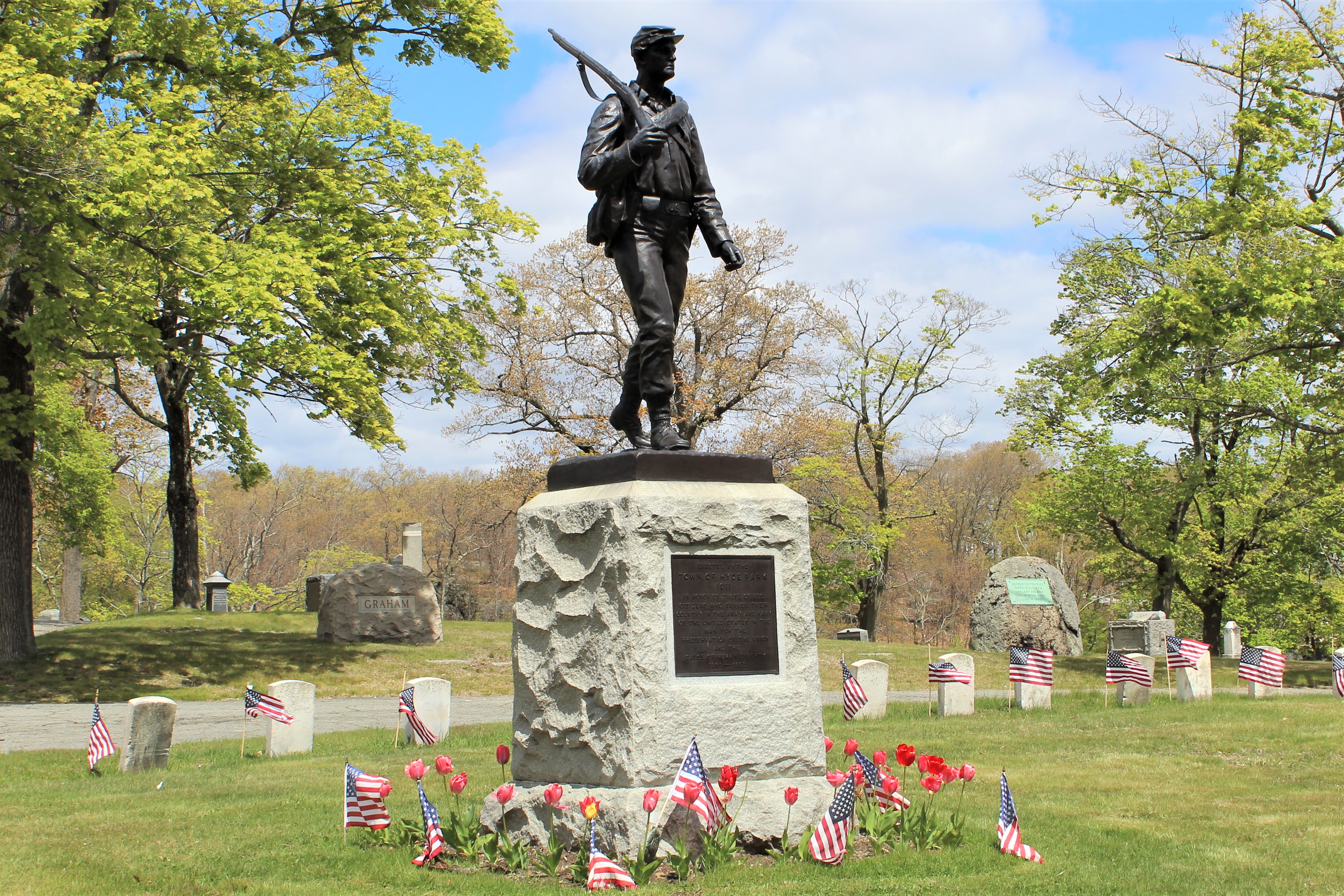
Location: Fairview Cemetery, 45 Fairview Avenue, Hyde Park
Coordinates: 42°14’48.3″N 71°08’31.4″W
Date dedicated: May 30, 1911
Architect/designer/manufacturer: Melzar Hunt Mosman, sculptor; Gorham Manufacturing Co., casting
During the war, Hyde Park was part of Dedham. In 1868 it was set off as its own town. As the 50th anniversary of the Civil War approached, citizens made plans to erect a soldiers’ monument in Fairview Cemetery dedicated to those who resided within the bounds of the new town who served. Just a year after the dedication of the monument, Hyde Park was annexed by Boston.
The statue was sculpted by Melzar Hunt Mosman. It is a copy of Mosman’s 1907 original which was created for the Massachusetts monument in the National Cemetery in Winchester, Virginia.[1] Mosman was a Civil War veteran, having enlisted with the 46th Massachusetts Infantry at age 19. He served in North Carolina and Mississippi and nearly died of fever during the Siege of Vicksburg. After the war he returned to work in Chicopee for a time and then worked at a foundry in Paris where he trained in bronze statue casting. He eventually started his own foundry, the Chicopee Bronze Works, where he sculpted and produced numerous bronze Civil War monuments, including several in Massachusetts (Northampton, Westfield, and Saugus being just a few examples). By the time he was commissioned to produce Hyde Park’s monument, his own foundry had closed and this statue was cast by the Gorham Manufacturing Company of New York. The statue was likely influenced by “The Volunteer” sculpted by Theo Alice Ruggles Kitson for Newburyport. The pose is similar and both are rare in depicting a soldier in light marching order (lacking some of his heavier standard-issue gear which soldiers often cast away). It is a more realistic depiction of the Union soldier as he actually appeared in the field.
The statue was erected on the soldiers’ plot belonging to the Grand Army of the Republic Timothy Ingraham Post 121 atop a hill in Fairview Cemetery. More than three thousand people were present for the dedication ceremonies on Memorial Day, 1911. The oration of the day was given by Rev. Joseph M. Shepler, pastor of Hyde Park’s Methodist Episcopal Church.[2]
The primary inscription reads, “Erected by the Town of Hyde Park 1911, In honor of those of its citizens who served their country in the Army and Navy of the United States in the War for the Preservation of the Union and the Cause of Human Liberty, 1861 – 1865.” While the word “slavery” is not used explicitly here, it is noteworthy that the makers of this monument incorporated the term “human liberty” into their name for the war placing it among the Massachusetts monuments which directly address emancipation.
Click to enlarge images:



Camp Meigs Park

Location: 11 Stanbro Street, Hyde Park
Coordinates: 42°14’05.2″N 71°07’56.3″W
Date dedicated: July 11, 1903
While we typically focus fairly strictly on municipal monuments dedicated to all those from a given town who served, there is a Civil War historical site in the Readville section of Hyde Park complete with appropriate memorials which should be included here due to its importance.
Camp Meigs in Readville was by far the most active training camp in the Commonwealth during the Civil War. The site, known as Sprague’s Plain before the war, had been frequently used as a mustering point for the local militia. In 1861, it was owned by a farmer named Ebenezer Paul who was surprised one morning to find men sitting under one of his elm trees who informed him that the Commonwealth required his land and that he would be compensated fairly for it.
The first units to set up on Sprague’s Plain in early July 1861 were the 18th Massachusetts and the 20th Massachusetts. After sending four early regiments off, the camp saw little use during the first half of 1862, until the call went out in August for nine-months regiments. At that time, a significant complex of barracks was built–also a hospital, stables and many other outbuildings. From that time forward, Camp Meigs was in constant use until the end of the war. In all, 28 units were trained here. And many more rendezvoused here at the end of their service to be paid and mustered out. No other camp in Massachusetts saw anything close to this level of activity during the Civil War.
Among the units that trained at Camp Meigs were the Commonwealth’s three African-American units: the 54th Massachusetts (the first such unit raised in the North), the 55th Massachusetts, and the 5th Massachusetts Cavalry. Much of the area is a residential neighborhood now. A small park of nearly three acres, named Camp Meigs Park, sits in the middle of this neighborhood on a piece of ground where a portion of the barracks once stood. A granite monument in the shape of a cannon was placed in 1903 when the park was dedicated by the Commonwealth. More recently, interpretive signage has been placed throughout the park as well as a marker dedicated to the three black regiments. The inscription on this monument reads, “Dedicated to the African American troops who trained here and distinguished themselves in the Civil War and to those who continue to fight for equal rights and equal justice.”
[1] “Hyde Park’s Tribute to Dead,” Boston Globe, May 27, 1911, 3.
[2] Boston Herald, May 31, 1911, 3.